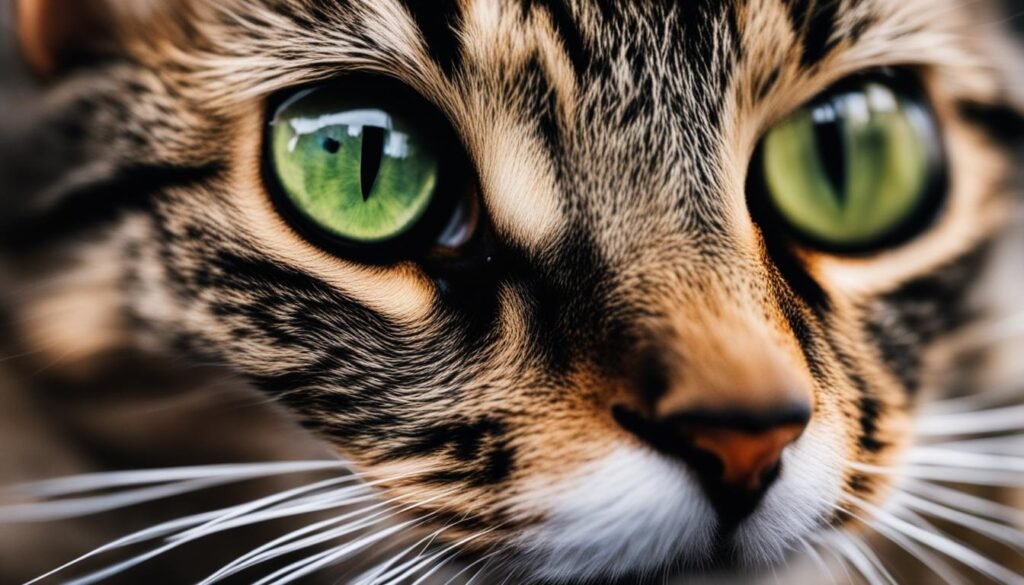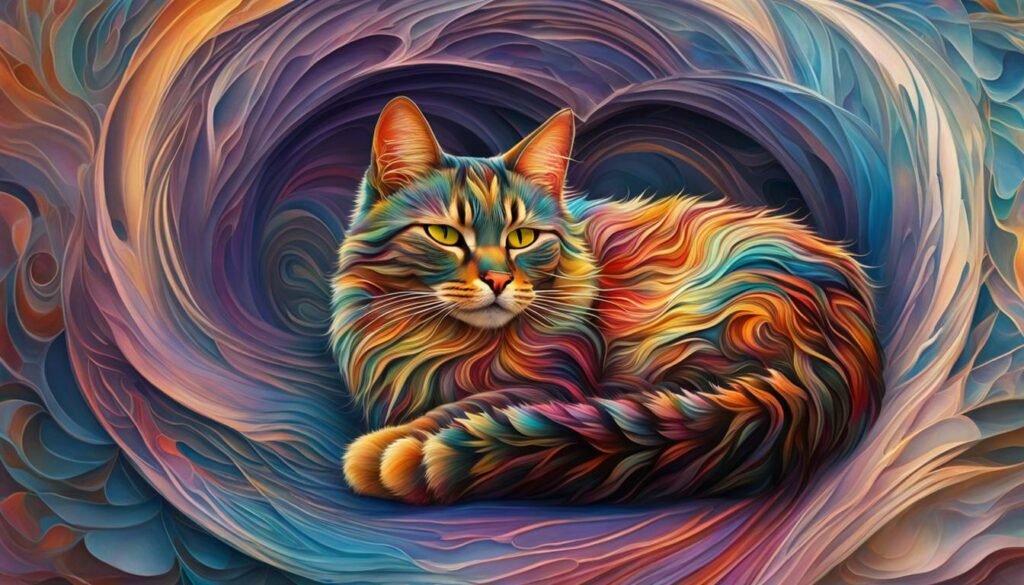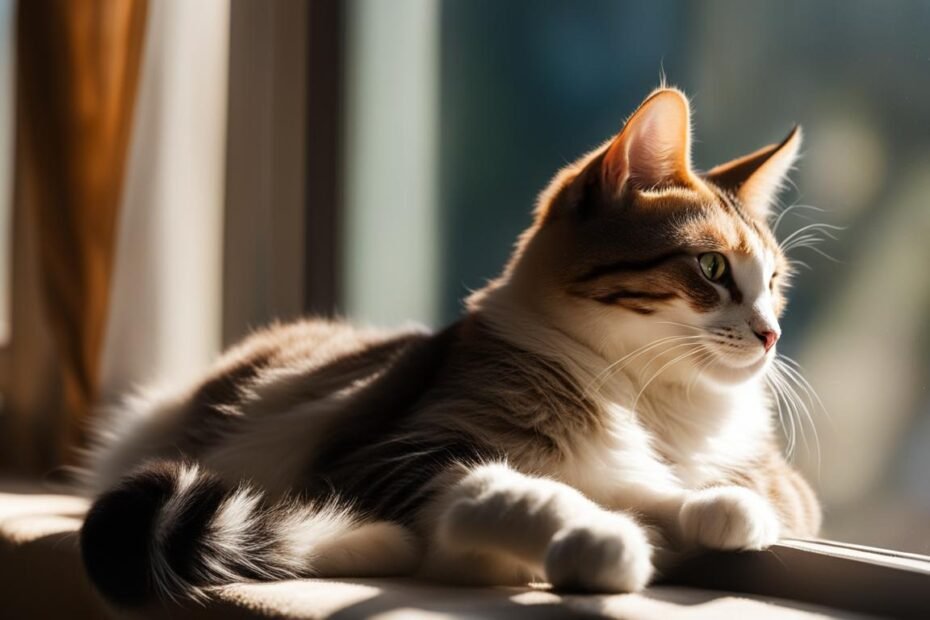Cats have always been intriguing creatures, captivating our attention with their mysterious behaviors. At Chiba University, Associate Professor Arii Watanabe is delving into the psychology of animals, particularly domesticated cats, to shed light on their behavior and the profound impact they have on our lives. By studying various aspects such as socialization, the intricate cat-human relationship, and the behavioral changes in domestic cats, Professor Watanabe aims to unravel the secrets behind their intriguing behavior.
Through groundbreaking behavioral experiments, Professor Watanabe explores the cognitive abilities and personalities of cats, seeking to understand how they perceive the world around them and interact with humans. Her research touches upon the concepts of metacognition, episodic memory, and even the innate emotion of fear in cats. By unraveling these mysteries, we gain a deeper understanding of our feline companions and the impact they have on our lives.
Key Takeaways:
- Cat behavior has a profound impact on our lives.
- Understanding domesticated cat behavior requires studying their socialization patterns.
- The cat-human relationship is a unique and complex bond.
- Behavioral changes in domestic cats can provide insights into their emotional well-being.
- Professor Watanabe’s research explores the cognitive abilities and personality traits of cats.
Understanding Comparative Cognition
Comparative cognition is a fascinating field that delves into the cognitive abilities of both humans and non-human animals. In the case of cats, studying their cognition requires conducting thorough animal experiments to gain insights into their cognitive processes. These experiments help researchers understand the intricate workings of the feline mind and how it differs from human cognition.
One aspect that researchers like Professor Watanabe explore is metacognition, which refers to the ability to monitor and reflect on one’s thoughts. By conducting invasive experiments that involve training cats to perform specific tasks, researchers can gauge whether cats exhibit metacognitive abilities. Such experiments provide valuable data on whether cats are aware of their own thought processes and have a level of consciousness similar to humans.
Episodic memory is another area of interest in comparative cognition. This type of memory involves remembering specific events from the past, including the time, place, and people or animals involved. Through behavioral experiments, researchers aim to determine whether cats possess episodic memory and can recall past events.
| Cognitive Abilities Studied in Comparative Cognition |
|---|
| Metacognition |
| Episodic Memory |
| Innate Emotions |
| Consciousness |
Furthermore, understanding the innate emotions of cats is another crucial aspect of comparative cognition. By observing cats’ behavioral responses in various situations, researchers can determine whether certain emotions, such as fear, are innate or learned through experience.
The study of comparative cognition and the cognitive abilities of cats provides valuable insights into the complex world of feline psychology. Through animal experiments and behavioral studies, researchers like Professor Watanabe strive to unravel the mysteries of cat behavior and shed light on the unique cognitive processes that shape their interactions with humans and their environment.
Overcoming Challenges in Cat Research
Researching cat behavior presents unique challenges due to the nature of these enigmatic animals. Cats are known for their independent and often unpredictable behavior, making them more difficult to work with compared to dogs. While dogs tend to be more cooperative in experiments, cats can be more reticent and may require additional efforts to encourage their participation.
This difference in behavior and cooperation levels has resulted in a bias towards research on dogs, with fewer studies focusing on cat behavior. However, this does not mean that cats are any less worthy of study. In fact, their distinctive behaviors and personalities make them fascinating subjects for research, if we can overcome the challenges associated with studying them.
Dr. Watanabe emphasizes the importance of finding innovative methods to study cat behavior. She believes that by addressing these obstacles, we can expand our understanding of cats and challenge the perception that dogs are more cognitively capable than cats.
| Challenges | Possible Solutions |
|---|---|
| Uncooperative behavior | Using positive reinforcement techniques to encourage participation |
| Limited sample size | Collaborating with multiple research institutions to increase sample diversity |
| Lack of standardized protocols | Developing comprehensive guidelines for consistent experimentation |
By addressing these challenges and finding innovative ways to study cat behavior, researchers like Dr. Watanabe are making significant strides in understanding the complexities of feline minds. Their work not only sheds light on the cognitive abilities and emotions of cats but also enhances our appreciation for the unique bond between cats and humans.
The Complex World of Cat Psychology
Understanding cat behavior goes beyond simple observations. Professor Watanabe’s research delves into the intricate workings of the feline mind, exploring various aspects of cat psychology that shape their behavior and interactions with humans. One area of focus is gaze fixation experiments, where cats are observed to determine their reactions to visual stimuli. The findings of these experiments suggest that individual personalities play a significant role in how cats respond to what they see.
By understanding the unique personalities of cats, we gain valuable insights into their behavior and can tailor our interactions with them. This knowledge helps foster a deeper bond between cats and their human companions, promoting a harmonious cat-human relationship. It also highlights the importance of recognizing cats as individuals with distinct preferences and emotions.
In addition to gaze fixation experiments, Professor Watanabe explores the concept of physical cause-and-effect relationships in cats. This research investigates whether cats have an understanding of basic physics and how they perceive physical interactions. By studying these relationships, we can gain a better understanding of how cats navigate their environment and interact with objects and other beings.
The complex world of cat psychology opens up a realm of possibilities for enhancing our understanding of feline behavior and strengthening the bond between cats and humans. Through Professor Watanabe’s research, we can gain valuable insights into the individual personalities of cats, their unique gaze fixation patterns, and their understanding of physical cause-and-effect relationships. By recognizing the complexity of cat psychology, we can build stronger connections with our feline companions and provide them with enriched and fulfilling lives.

The Multifaceted Behavior of Purring
Purring is a fascinating behavior that serves multiple purposes in the feline world. It is commonly associated with contentment and happiness, but cats also purr when they are frightened or in pain as a self-soothing mechanism. Research has shown that the frequency at which cats purr can actually promote healing, reduce pain, and decrease swelling. This suggests that purring has a built-in healing mechanism for cats, making it a truly remarkable behavior.
In addition to its physical benefits, purring also plays a crucial role in communication between mother cats and their kittens. Kittens, even when they are blind and deaf, can feel the vibration of their mother’s purr. This helps guide them to safety and warmth. It’s a remarkable example of how cats use purring to communicate and nurture their young.
“Purring is a complex behavior that showcases the multifaceted nature of cats and their ability to communicate and heal.”
Understanding the multifaceted nature of purring provides valuable insights into the behavior of these fascinating animals. It highlights their innate self-soothing abilities and the importance of purring in the cat-human relationship. Purring is not just a simple sound; it’s a powerful mechanism that showcases the complexity and depth of feline communication and healing.
The Healing Power of Purring
The healing properties of purring are truly remarkable. Studies have shown that purring vibrations range from 20 Hz to 140 Hz, which coincides with the frequency range known to promote healing and repair of bones and soft tissues in humans. The vibrations created by purring may stimulate the production of growth factors and aid in the regeneration of damaged tissue.
Furthermore, the act of purring releases endorphins, which are natural painkillers. This may explain why cats often purr when they are injured or in pain. By purring, they may be soothing themselves and alleviating discomfort.
The healing power of purring extends beyond physical benefits. The act of purring can also have a calming effect on the human caregiver. The rhythmic sound and gentle vibrations can provide a sense of comfort and tranquility, reducing stress and promoting relaxation.

| Benefits of Purring | Examples |
|---|---|
| Promotes healing | Reduces pain and swelling |
| Self-soothing mechanism | Helps cats calm themselves in stressful situations |
| Communication between mother cats and kittens | Guides kittens to safety and warmth |
In conclusion, purring is a remarkable and multifaceted behavior that holds great significance in the feline world. It serves as a self-soothing mechanism, facilitates communication between mother cats and kittens, and even has healing properties. Understanding the complexities of purring deepens our appreciation for the unique abilities of cats and enhances our understanding of their behavior.
Exploring the World of Feline Literature
The world of literature offers a captivating array of feline-inspired books that celebrate the unique bond between humans and cats. Whether you’re a parent looking to foster a love for feline friends in your child or an adult seeking to delve into the special relationship between humans and cats, there is a wide range of books to choose from. These feline-inspired books provide delightful and age-appropriate content that sparks joy and curiosity in readers of all ages.
For young readers, children’s books centered around cats offer a fantastic introduction to the feline world. From classics like “The Cat in the Hat” by Dr. Seuss to modern favorites like “Pete the Cat” by James Dean, these books feature charming illustrations and heartwarming stories that capture the imagination. They teach valuable lessons about empathy, responsibility, and the joy of companionship. Whether it’s a mischievous kitten’s adventures or a heartwarming tale of friendship, these books create a lifelong love for feline companions.
Adult literature also explores the special bond between humans and cats, delving into themes of companionship, understanding, and the mysteries of feline behavior. Books like “Dewey: The Small-Town Library Cat Who Touched the World” by Vicki Myron and “The Travelling Cat Chronicles” by Hiro Arikawa offer captivating narratives that explore the depths of the cat-human relationship. These stories provide a glimpse into the unique world of cats, evoking laughter, tears, and a profound appreciation for their intricate personalities.
“A home without books is a body without a soul.” – Marcus Tullius Cicero
Feline-inspired literature not only entertains but also deepens our understanding of the bond between humans and cats. It allows us to explore the enriching and intricate relationship we share with these captivating creatures. So whether you’re looking for a charming bedtime story for your child or a captivating novel for yourself, delve into the wonderful realm of feline-inspired books and embark on a literary journey that celebrates the magic of cat companionship.
| Table: Feline-Inspired Books | Age Group | Book Title | Author |
|---|---|---|---|
| Children’s Books | Preschool to Elementary | The Cat in the Hat | Dr. Seuss |
| Pete the Cat | James Dean | ||
| Adult Literature | Young Adult and Above | Dewey: The Small-Town Library Cat Who Touched the World | Vicki Myron |
| The Travelling Cat Chronicles | Hiro Arikawa |
Conclusion
Understanding cat behavior is essential for fostering a deep and meaningful cat-human relationship. By delving into the intricacies of their behavior, we can enrich our lives and strengthen the bond we share with our feline companions.
Through extensive research and careful observation, experts like Professor Arii Watanabe have shed light on the mysteries of cat behavior, creating a deeper understanding of their cognition, personalities, and emotional lives. This knowledge not only provides fascinating insights into the complex world of cats, but also helps us navigate our interactions with them more effectively.
It is through research that we uncover the importance of cat behavior impact on our lives, enabling us to create environments that promote their well-being. By understanding their needs, preferences, and unique communication methods, we can cultivate a harmonious and fulfilling cat-human relationship.
Research on cat behavior is more than just a scientific endeavor; it is a way to enhance our lives and the lives of our feline companions. By appreciating the value of research in understanding cat behavior, we can create environments that nurture their natural instincts while also providing them with love, care, and enrichment. Through this understanding and commitment, we can truly create a world where cats and humans thrive together.
FAQ
What is the purpose of studying cat behavior?
Studying cat behavior helps deepen the cat-human relationship and enrich our lives by understanding their cognition, personalities, and emotional lives.
What is comparative cognition?
Comparative cognition involves conducting animal experiments to understand the cognitive abilities of both humans and non-human animals.
Why is researching cat behavior challenging?
Cats are often less cooperative in experiments compared to dogs, requiring researchers to find innovative ways to encourage their participation.
What is the significance of gaze fixation experiments in cats?
Gaze fixation experiments help understand how cats respond to visual stimuli and how individual personalities play a role in their reactions.
What is the purpose of purring in cats?
Purring serves multiple purposes, including communication, self-soothing, and promoting healing in cats.
What kind of literature is available on the bond between cats and humans?
There is a wide range of feline-inspired literature available, including children’s books and adult literature that explores the special relationship between humans and cats.
Why is understanding cat behavior important?
Understanding cat behavior helps deepen the cat-human relationship, and it offers insights into their impact on our lives and the unique bond between cats and humans.
